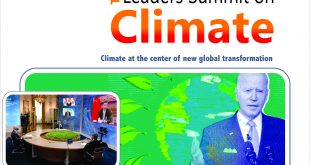During his inaugural address, Supreme Iranian leader Ayatollah Ali Khamenei made it clear that his country was pursuing nuclear technology for peaceful purpose.
Another high point of Summit was President Zardari’s meeting with Ahmadinejad in which both leaders discussed the IP gas pipeline project, the Taftan-Quetta power transmission line, the Gwadar power supply project, the construction of Noshki-Dalbandin part of Quetta-Taftan Highway and upgrading of the Quetta-Taftan railway track.
Attended by over 120 countries, which is about two-thirds of the UN member countries as well as 55% of the world population, the Non-Aligned Movement (NAM) mainly represents the developing world. Founded in Belgrade in 1961 at a time when the world was defined by increasing polarisation, the NAM provided a platform to the countries which abhorred the idea of bloc politics and refused to be sucked into ‘with us or against us’ syndrome.
The organisation was founded on the five principles, namely mutual respect for each other’s territorial integrity and sovereignty, mutual non-aggression, mutual non-interference in domestic affairs, equality and mutual benefit and peaceful co-existence.
Following the end of Cold War and the establishment of the unipolar world order led by the United States, the Non-Aligned Movement has struggled to keep itself relevant to the global affairs by seeking to represent the aspirations of the developing countries. However, some analysts are of the view that given its size and broad nature of its objectives, the NAM has been reduced to a debating forum with little concrete to offer in terms of performance or results.
The 5-day NAM summit, which concluded in Tehran on August 31, was the focus of media attention for different reasons. The proceedings of the summit got underway in the background of increasing tensions between the US and Iran, the host of the summit, over its nuclear programme, and widening rifts over Syrian stalemate.
Despite the US’ efforts to isolate Iran diplomatically through a mix of economic sanctions, diplomacy and threats, which was also evident from Washington’s pressure on UN Secretary-General Ban Ki-moon not to attend the summit, the host country did make an effort to project the holding of the conference as its diplomatic victory. The interesting part of the summit was the attendance of the Egyptian president who was the first leader of his nation to visit Iran after revolution in 1979.
As the summit opened, row over Iran’s nuclear programme and developments in Syria cast their shadow and led to some uneasy moments during the proceedings. During his inaugural address, Supreme Iranian leader Ayatollah Ali Khamenei made it clear that his country was pursuing nuclear technology for peaceful purpose. He alleged the United Nations Security Council of exerting ‘overt dictatorship’ on Iran at the behest of the US, UK, and France.
In his speech to the Summit, the UN Secretary-General urged the Iranian leadership to fully comply with relevant UNSC resolutions and thoroughly cooperate with the IAEA. He also warned that ‘a war of words can quickly spiral into a war of violence’. Parchim nuclear facility is at heart of recent tensions between Iran and the Western world, which has accused Tehran of undertaking suspicious activities there. Iran has disallowed IAEA access to Parchim facility. IAEA has said that it has documentary evidence collected by ‘some foreign agencies’ about Iran’s involvement in nuclear activities at the said facility. It refused to share the evidence with the Iranian government though.
Mohamed Morsi, President of Egypt, in his address also supported the movement against the Syrian regime. He said ‘The revolution in Egypt is the cornerstone for the Arab Spring, which started days after Tunisia and then it was followed by Libya and Yemen and now the revolution in Syria against its oppressive regime.’ These comments led the attending Syrian delegation led by the prime minister to stage a walk out of the summit.
The NAM also provided an opportunity to the Pakistani and Indian leaderships to meet on the sidelines of the summit and discuss a whole host of issues. The meeting between President Zardari and Prime Minister Manmohan Singh, which was described as ‘good’ by Foreign Minister Hina Rabbani Khar, mulled ways and means to further advance the peace process. The Pakistani president extended an invitation to the Indian premier to visit Pakistan. He also spoke of the need to move beyond reiteration of position to substantive results, adding that Pakistan was committed to pursuing the peace process with India.
The trilateral meeting between India, Iran and Afghanistan before the start of the NAM Summit decided to set up a joint working group to bolster trade and economic relations. President Hamid Karzai of Afghanistan identified terrorism as the biggest challenge impeding the development of the region. He underlined the imperative of regional cooperation to defeat and defang terrorism and extremism.
The resolution adopted at the end of the NAM summit supported Iran’s right to nuclear technology for peaceful purpose and called for greater efforts to support the Palestinian cause. It also advocated multilateralism and adherence the UN charter to resolve conflicts and achieve peace on durable basis.
 Jahangir's World Times First Comprehensive Magazine for students/teachers of competitive exams and general readers as well.
Jahangir's World Times First Comprehensive Magazine for students/teachers of competitive exams and general readers as well.


